In 1983, Taft Entertainment and Paramount Pictures promised audiences "a new name for terror: Cujo," and over three decades later, still holds up as a harrowing viewing experience anchored by a career-best Dee Wallace Stone performance. However, while Cujo 's basic plot seems to be well known it's oft-forgotten that the movie isn't really about a rabid, 200-pound St. Bernard terrorizing a mother and her young song in a broken down Ford Pinto during a heat wave. That's literally what happens, but it's what Cujo symbolizes which gives the film it's true power. Yeah, that dog scary, but so is Dee Wallace when she's pushed too far.
That's what I learned from watching Cujo for the first time for " The Stephen King Files," a recurring feature on the site where I watch and dissect old Stephen King movies I've never seen before. Thus far, Cujo is my favorite of the bunch and by a pretty wide margin. At a brisk 93-minutes, it is a quick and dirty woman-in-peril exploitation picture that plays a bit like a slasher with Cujo as the killer and Dee Wallace as the Final Girl.
It's also - on a deeper level - a movie about a group of vile or simply inept men repeatedly failing women before one mother finally has enough and learns to stand up for herself during a truly hellish ordeal, defeating a mindless, male killing machine mere days after her spurned lover tried to rape her. Of course, you don't have to appreciate or notice any of that to enjoy the film's genre thrills, but it helps.
" Cujo was the hardest thing I've ever done, and it's the film I'm proudest of," Wallace recently said, as quoted in The Complete Guide to Stephen King.
King holds the film in a similarly high regard, repeatedly calling it one of the best adaptations of his work. If only he could remember writing it.
The Backstory Behind the Book
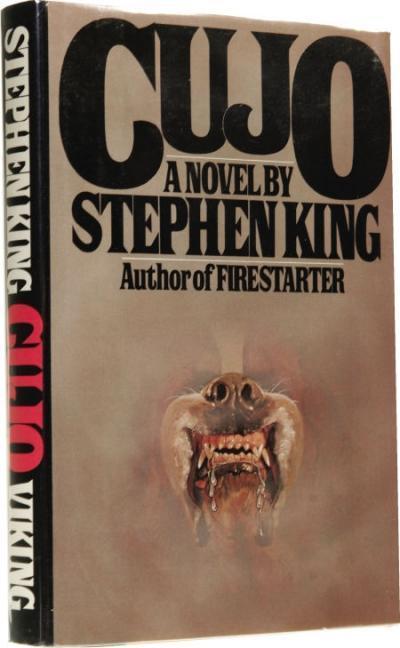
Written in 1977 and published in 1981, Cujo was reportedly inspired by King's encounter with a scary St. Bernard at a remote garage, but it also grew out of his desire to challenge himself. "I'd always wondered whether or not it would be possible to write a novel restricted to a very small space," he told Starburst, "and my first idea was whether or not it would be possible to write a 400-page novel that was entirely set in a stalled elevator. And then it sort of expanded to the idea of the automobile, and I couldn't keep it all in the automobile - I felt I had to lead up to it. But I began to think of it has a low-budget novel. It was like a movie, it's more visual than any of the others, because the setting is so restricted."
That comes from an interview conducted closer to the novel's publication. In the decades since, King recollection has grown far hazier. He has added Cujo to the surprisingly long list of books he doesn't totally remember writing since he was losing his battle with alcoholism at the time and also ingesting an astonishing amount of cocaine. Either way, Cujo became his 7th published novel, 10th when you included the Richard Bachman titles, and while a best seller it was not without controversy.
Spoiler, in the book the boy dies at the end, and as Dee Wallace recently told Grue Monkey, "[King] said he never received so much hate mail as he did regarding the boy dying."
The Backstory Behind the Movie
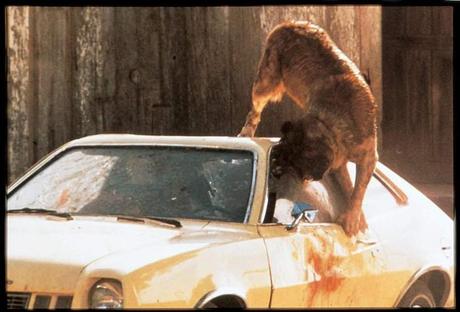
King wrote Cujo to feel like a low-budget movie, which might explain why it went through the usually slow Hollywood development process with lightning speed, hitting theaters just two years after landing on bookshelves. Taft Entertainment - the film production arm of a century-old broadcasting conglomerate linked to the family of U.S. President William Howard Taft - had recently acquired Sunn Classic Pictures, and the merged entities were about to unfurl a run run of memorable 80s genre efforts like Big Trouble in Little China, Running Man, and The Monster Squad. Cujo was first on that docket.
Taft optioned the film rights the year the book was published and hired King to write the screenplay. "I thought my script was pretty good. It was not as faithful to the book as the final result was," he said. He was rewritten by two TV Movie specialists - Barbara Turner (who used the pen name "Lauren Currier") and Don Carlos Dunaway - and when it came time for accreditation Turner formally lodged a WGA protest against granting King a writing credit. "I was in England at the time, and I just didn't have time to mess it," he told Cinefantastique.
King was also nonplussed about Taft's decision to change the ending from the book. He actively fought against any effort from his publisher to give the story a happy ending. No, in his conception the book ends - again, spoiler - with the child ultimately dying even though his mother defeats the damn dog. That was non-negotiable. As for the movie, though, "I told them, 'Fine, let the kid live and see how it works.' I was never really against the idea."
Production took place in Mendocino California in Northern California on a budget of $5 million. The original director - The Changeling's Peter Medak - dropped out after the first or second day of shooting as did his cinematographer Tony Richardson. They were replaced by Lewis Teague (a longtime Roger Corman editor with plenty of TV directing and three feature films to his name) and future Speed filmmaker Jan De Bont, respectively. Filming lasted a little over eight weeks - five for the in car sequences alone.

Multiple actual St. Bernards as well as several mechanical dogs were used to play Cujo, and for certain shots the production attempted to put a stunt person as well as other dog breeds, like a German Shepherd, into a St. Bernard costume.
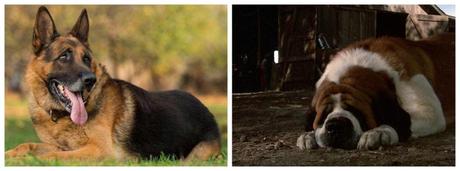
Either way, the effect was often genuinely terrifying. Stone told Starburst at the time that both she and Danny Pintauro, the actor playing her son, were "scared to death." Their screams are quite real.
Audiences could certainly feel that. Cujo became the second highest-grossing horror movie of 1983, trailing Jaws 3-D by a wide margin. Notably, 1983 also saw the release of two other Stephen King movies: Christine and The Dead Zone. Cujo sold more tickets, but not by much. There's only around $1 million in box office separating the three on the year-end chart.
Watching the Movie for the First Time in 2019
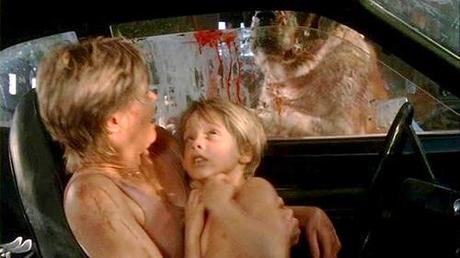
The most effective horror is the kind you can't explain away. Battling vampires, ghosts, dream demons, zombies, or any other matter of supernatural entity makes for great horror storytelling, but there's always the barrier between you and the art. You can rationalize your way out of being truly scared because you know what you're watching could never really happen to you or is, at the very least, quite improbable.
That's the lesson Vic Trenton (Daniel Hugh-Kelly) repeatedly tries to teach his young song son Tad (Pintauro) throughout Cujo. "There are no real monsters" becomes his soothing mantra. Except there are real monsters. The child is convinced there is a ghost in his closet. In the book, there quite literally is; in the film, it might just be his imagination. That rabid, 200-pound St. Bernard outside the car window, however, is very real, and neither Tad nor his mom can wish it away.
Thus the power of Stephen King's Cujo. The scenario is something which could happen to any one of us, and it's simple and straightforward a Stephen King premise as I think I've ever seen, forever the champ of the "scary dog" horror subgenre. However, it's actually a full 53-minutes before the film gets to its "dog hunts woman and child trapped in car" showcase. In the buildup, we meet unhappy housewife Donna (Wallace), her brutish lover (Christopher Stone), distracted husband Vic, and perpetually afraid son Tad.
As their story unfolds, we also glimpse the miserable lives of a neighboring couple - a drunken mechanic (Ed Lauter), his cowering wife (Kaiulani Lee), their son (Billy Jacoby), and a certain dog named Cujo. Though it is never outright spoken, when the wife leverages several thousand dollars in local lottery winnings to convince the man to let her take the kid and visit her sister you get the impression that she has no intention of ever coming back.
So desperate for escape is she that she knowingly leaves behind a potential rabid Cujo, apparently fearing that bringing it up to her husband would potentially ruin her escape plan. However, while she literally buys her freedom Donna's path isn't so easy. She has the misfortune of encountering Cujo after the ole pup has already murdered a few and has an appetite for more, setting the stage for a tour de force in claustrophobic horror as mother and child fend off a beast and flirt with possibly dying from heat exhaustion before all is said and done. Never before have the words "Fuck you, dog" felt so cathartic.
All Hail Dee Wallace

The history of women in film always includes a chapter on Linda Hamilton in Terminator 1 & 2 and Sigourney Weaver in the Alien franchise as iconic examples of important action heroines defying gender stereotypes. Wallace's Cujo performance as a desperate housewife turned fierce warrior and survivor deserves to be in that same chapter. The experience of making the movie led her to be treated for exhaustion but it was worth it.
Spare Some Sympathy for the Poor Dog
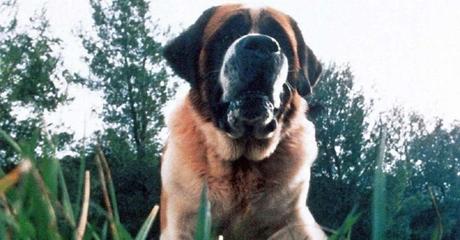
File the following away for your next trivia night: which Stephen King villain has been referenced the most across all of his books and short stories? Is it A. Randall Flagg, B. Pennywise, C. Cujo, or D. Christine?
The answer, according to The Complete Guide to Stephen King, is C. (Randall Flagg has easily the most page time of any of them, but in terms of whose name has popped up the most it's Cujo.) First introduced in the 1981 novel and then the 1983 film, Cujo has gone on to be referenced in - just to name a few - Pet Sematary, The Tommyknockers, The Dark Half, Needful Things, and the show Castle Rock. Beyond all of that, like Carrie before him and Christine after, Cujo is now a part of our popular vernacular. It's the name you use to refer to a bad dog even if you've never read or seen Cujo and don't even remember how or why you know that name. You just do.
However, when you actually watch the movie it's not hard to feel a bit of sympathy for the poor dog. We are told early on that he's a gentle dog, and the Rockwellion opening sequence of him innocently chasing a rabbit through a field certainly gives the impression of a healthy dog. Once that chase leads him into a darkened underground cave and a losing encounter with some bats, however, the clock begins its countdown to the moment that Cujo stops being Cujo and turns into a mindless killer. His gradual mental and physical decline rather effectively mirrors the dissolution of the marriages around him, and by the end of the film his matted coat and puss/blood-coverd face renders him totally unrecognizable.
An effective storytelling device, sure, but also a little sad. As King wrote in the novel: "It would perhaps not be amiss to point out that he had always tried to be a good dog. He had tried to do all the things his MAN and his WOMAN, and most of all his BOY, had asked or expected of him. He would have died for them, if that had been required. He had never wanted to kill anybody. He had been struck by something, possibly destiny or fate or only a degenerative nerve disease called rabies. Free will was not a factor."
Sources: The Complete Guide to Stephen King, Creepshows: The Illustrated Stephen King Movie Guide, Hollywood's Stephen King by Tony Magistrale
Previously:
Next time:
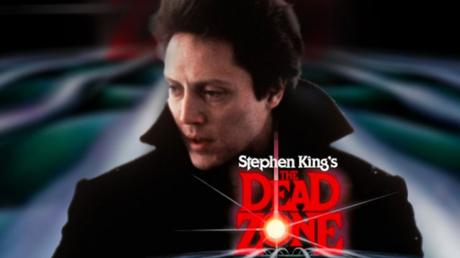

Grew up obsessing over movies and TV shows. Worked in a video store. Minored in film at college because my college didn't offer a film major. Worked in academia for a while. Have been freelance writing and running this blog since 2013. View all posts by Kelly Konda

